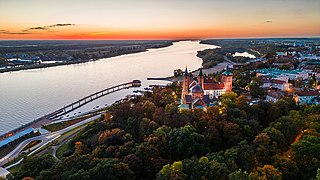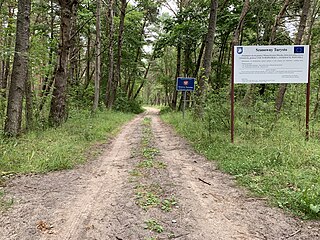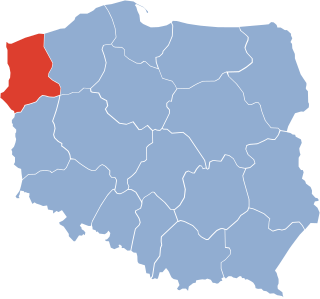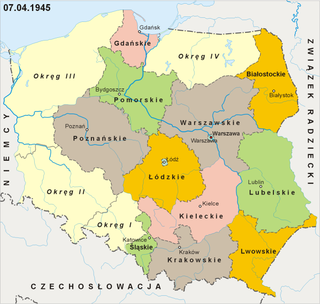
East Prussia was a province of the Kingdom of Prussia from 1773 to 1829 and again from 1878 ; following World War I it formed part of the Weimar Republic's Free State of Prussia, until 1945. Its capital city was Königsberg. East Prussia was the main part of the region of Prussia along the southeastern Baltic Coast.

The Masurian Lake District or Masurian Lake Land is a lake district in northeastern Poland within the geographical region of Masuria, in the past inhabited by Masurians who spoke the Masurian dialects. It contains more than 2,000 lakes. The district had been elected as one of the 28 finalists of the New 7 Wonders of Nature.

Białystok Voivodeship was a unit of administrative division and local government in Poland from 1944 to 1975, when its purview was separated into eastern Suwałki Voivodeship, Łomża Voivodeship and Białystok Voivodeship (1975–1998). Its capital city was Białystok. The establishment of Podlaskie Voivodeship in 1999 was essentially a reunion of the areas of Białystok Voivodeship (1945–1975).

Stanisław Józef Srokowski was a Polish geographer and diplomat.

Mazovia or Masovia is a historical region in mid-north-eastern Poland. It spans the North European Plain, roughly between Łódź and Białystok, with Warsaw being the unofficial capital and largest city. Throughout the centuries, Mazovia developed a separate sub-culture featuring diverse folk songs, architecture, dress and traditions different from those of other Poles.

The modern Poland–Russia border is a nearly straight-line division between the Republic of Poland and the Russian Federation exclave Kaliningrad Oblast, a region not connected to the Russian mainland. It is 232 kilometres (144 mi) long. The current location and length of the border was decided in the aftermath of World War II. In 2004, it became part of the boundary of the European Union and the Commonwealth of Independent States.

The District of Opolian Silesia, also designated as the 1st District, was a district that acted as an provisional administrative division of Poland, during the administration of the Provisional Government of the Republic of Poland in 1945, and the Provisional Government of National Unity from 1945 to 1946. It was centered around the area of the Upper Silesia. It was established as one of four provisional districts on 14 March 1945, and existed until 28 June 1946, when it was abolished and incorporated into the Silesian Voivodeship. The head of the district was the attorney-in-fact of the government, Aleksander Zawadzki.

The District of Western Pomerania, also designated as the 3rd District, was a district of Poland, during the administration of the Provisional Government of the Republic of Poland in 1945, and the Provisional Government of National Unity from 1945 to 1946. It was established as one of four districts on 14 March 1945, as one of the four districts created to administer the area known as the Recovered Territories, acquired by Poland from Nazi Germany, during, and in the aftermath of World War 2. It was formed within the boundaries of former German provinces of Brandenburg, and Pomerania, and consisted of the area of the Farther Pomerania and Lubusz Land. On 25 September 1945, its southern part was incorporated into the Poznań Voivodeship. It existed until 28 June 1946, when it was abolished and incorporated into the Szczecin Voivodeship.

The Lower Silesian District, also designated as the 2nd District, was a district that acted as an provisional administrative division of Poland, during the administration of the Provisional Government of the Republic of Poland in 1945, and the Provisional Government of National Unity from 1945 to 1946. It was centered around the area of the Lower Silesia. It was established as one of four provisional districts on 14 March 1945. On 25 September 1945, the territories near its northern border were incorporated into the Poznań Voivodeship. It existed until 28 June 1946, when it was abolished and replaced with the Wrocław Voivodeship. The head of the district was the attorney-in-fact Stanisław Piaskowski.

The Szczecin County was a county centered around the town of Police, that existed from 1946 to 1975. In 1946 it was a subdivision of the District of the Western Pomerania, and from 1946 to 1975, of the Szczecin Voivodeship. Its seat of government was located extrateritorially in the nearby city of Szczecin.

The Szczecin Voivodeship was a voivodeship (province) with its capital in Szczecin, that was centered on the Farther Pomerania. It existed from 1946 to 1975. Until 19 February 1947 it was under the administration of Provisional Government of National Unity, which then was replaced by the Polish People's Republic. It was established on 28 June 1946, when it was carved out of the territory of the District of the Western Pomerania, and parts of the Gdańsk, and Pomeranian Voivodeships. On 6 July 1950, its eastern half was incorporated into then-established Koszalin Voivodeship, and the voivodeship ceased to exist on 31 May 1975, when it was replaced by then-established Szczecin and Gorzów Voivodeships.

The Gdańsk Voivodeship was a voivodeship (province) with capital in Gdańsk, that was located in the region of Pomerelia. It existed from 1945 to 1975. Until 28 June 1945, it remained under the administration of the Provisional Government of the Republic of Poland, which then was replaced by the Provisional Government of National Unity. On, 19 February 1947, the provisional government was replaced by the Polish People's Republic. It was established on 7 April 1945, from the parts of the territories of the Pomeranian Voivodeship, and the Masurian District, Poland. The voivodeship ceased to exist on 31 May 1975, when it was partitioned by then-established voivodeships of Elbląg, Gdańsk, and Słupsk.

The Warsaw Downtown County was a county within the city of Warsaw. It existed from 1931 to 1939, and from 1944 to 1960, as a county of Warsaw, that functioned as the voivodeship. From 1931 to 1939, it was under the administration of the Second Polish Republic, from 1944 to 1945, under the Provisional Government of the Republic of Poland, from 1945 to 1947, under the Provisional Government of National Unity, and from 1947 to 1960, under the Polish People's Republic.
The West Warsaw County was a county within the city of Warsaw. It existed from 1944 to 1960, as a county of Warsaw, an independent city, that functioned as a voivodeship. From 1944 to 1945, it was under the administration of the Provisional Government of the Republic of Poland, from 1945 to 1947, under the Provisional Government of National Unity, and from 1947 to 1960, under the Polish People's Republic.

The Chojna County was a county centered around the towns of Chojna and Dębno, that existed from 1945 to 1975. From 1945 to 1946, it was located in the District of the Western Pomerania, and from 1946 to 1975, in the Szczecin Voivodeship. Its seat was located in the towns of Dębno, and briefly in 1945, Chojna. In 1946, it had 19 537 inhabitants, and an area of 1374 km². Currently, its former area is under the administration of the counties of Gryfino and Myślibórz, located in West Pomeranian Voivodeship, Poland.

The Warsaw Voivodeship was a voivodeship (province) of the Polish People's Republic, with capital in Warsaw, that was located in Masovia. It was established on 22 August 1944, and until 28 June 1945, it remained under the administration of the Provisional Government of the Republic of Poland, which then was replaced by the Provisional Government of National Unity. On, 19 February 1947, the provisional government was replaced by the Polish People's Republic. It existed until 31 May 1975, when it was partitioned into the voivodeships of Biała Podlaska, Białystok, Ciechanów, Lublin, Łomża, Ostrołęka, Płock, Radom, Siedlce, Skierniewice, and Warsaw Capital.

The Lwów Voivodeship was a short-lived voivodeship (province) of Poland, with capital in Rzeszów, that existed from 1944 to 1945. It was established on 22 August 1944, and until 28 June 1945, remained under the administration of the Provisional Government of the Republic of Poland, which then was replaced by the Provisional Government of National Unity. It existed until 18 August 1945, when it was incorporated into then-established Rzeszów Voivodeship.

The Silesian Voivodeship, also known as the Basin–Silesian Voivodeship, and the Silesian–Dąbrowa Voivodeship, was a voivodeship (province) of Poland, with capital in Katowice, that existed from 1945 to 1950. It was located in the Upper Silesia. The voivodeship was established in 1945 and until 28 June 1945, remained under the administration of the Provisional Government of the Republic of Poland, which then was replaced by the Provisional Government of National Unity. On, 19 February 1947, the provisional government was replaced by the Polish People's Republic. On 28 June 1946, the District of Opolian Silesia had been incorporated into the voivodeship. It existed until 6 July 1950, when it was partitioned into the voivodeships of Katowice and Opole.

The Maritime County was a county centered around the Gdynia and Wejherowo, that existed from 1927 to 1939, and from 1945 to 1951. From 1927 to 1939, it was located in the Pomeranian Voivodeship, in the Second Polish Republic. In 1945, it was located in the Pomeranian Voivodeship, and from 1945 to 1951, it was located in the Gdańsk Voivodeship, which, in 1945 were under the administration of the Provisional Government of the Republic of Poland, from 1945 to 1947, under the administration of the Provisional Government of National Unity, and since 1947, under the administration of the Polish People's Republic. Until 1928, its seat was located in the city of Gdynia, and was since then moved to Wejherowo.


















